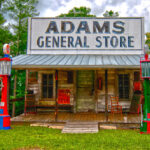Pioneer Museum of Alabama
 The Pioneer Museum of Alabama is located in the town of Fort Payne in east-central Alabama. This small town of about 3,000 people sits at an elevation of 1,300 feet. As you can see by the pictures below, much of it looks like a farmstead from the 19th century. The Pioneer Museum’s location also helps explain its name. The museum focuses on early settlers and their way of life. When they first came to this area in the 1820s, it was not yet part of the United States. They had to travel westward to reach a land stretching as far as their eyes could see. And that is exactly what they did — they built farms, homes, businesses and churches along their route to the west. It took them several days to reach their new home but when they arrived, they saw a beautiful place where they could start anew. You can visit this museum at 248 US-231, Troy, AL 36081. Here are some facts about this 19th-century farmstead that made it into the 21st century:
The Pioneer Museum of Alabama is located in the town of Fort Payne in east-central Alabama. This small town of about 3,000 people sits at an elevation of 1,300 feet. As you can see by the pictures below, much of it looks like a farmstead from the 19th century. The Pioneer Museum’s location also helps explain its name. The museum focuses on early settlers and their way of life. When they first came to this area in the 1820s, it was not yet part of the United States. They had to travel westward to reach a land stretching as far as their eyes could see. And that is exactly what they did — they built farms, homes, businesses and churches along their route to the west. It took them several days to reach their new home but when they arrived, they saw a beautiful place where they could start anew. You can visit this museum at 248 US-231, Troy, AL 36081. Here are some facts about this 19th-century farmstead that made it into the 21st century:
People Built Dwellings to Match Their Customs
The first settlers in the state of Alabama were mainly from the southern colonies of Virginia and North Carolina. They brought their own architecture and customs with them. Most of them had lived in the coastal regions of the Carolinas, Georgia and Virginia. For these people, constructing a dwelling was a reflection of their own culture and customs.
Churches Were a Special Part of Life
In the early 19th century, settlers were also influenced by the people who had settled in the eastern United States. These people had been primarily from the British Isles. They had come to the America during the early colonial period. As a result, many churches that were built in the state of Alabama were built based on a British architecture. Most of these churches used cedar wood for their construction and windows illuminated the ceiling and walls with special patterns.
Farm Equipment Was the Heart of the Farmstead
The farmstead was the core of the farming community. Besides houses, farms and plantations, many early settlers also ran businesses on the farmstead. As a result, many early farms included a general store, a tavern and a blacksmith shop. The farmstead was the heart of the farming community.
Streams and Rivers Defined What You Could Do on the Farm
The waterways were the core of the transportation system in the state of Alabama. The waterways were the core of the transportation system in the state of Alabama. These waterways were also the reason why many settlers ended up living on the banks of rivers. Most of the rivers in the state were fast-flowing and as a result, were ideal for navigation. Early settlers often used these rivers to transport goods from one part of the state to another.
The End
As you can see from the information above, the 19th-century farmstead in the state of Alabama was a working place where people grew food, ran businesses, constructed buildings and transported goods. These people were also influenced by British culture and architecture. The state of Alabama is rich in history, and it is not surprising that this state has a museum dedicated to the history of 19th-century life in America. The Pioneer Museum of Alabama is a good place to visit and learn more about this period of American history.
Driving Directions To Luther's Lock-it Self-Storage From Pioneer Museum of Alabama
Driving Directions To Christmas in Ansley